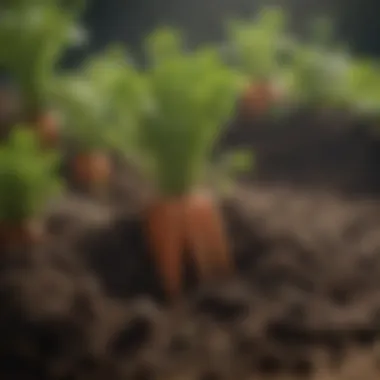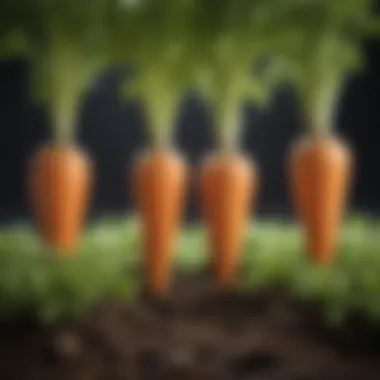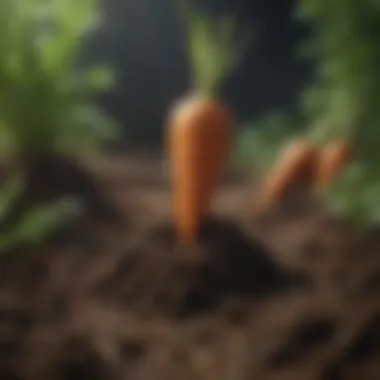Optimal Potting Soil for Carrots: Essential Considerations


Intro
Growing carrots in pots can be a rewarding experience, but it necessitates careful attention to soil composition. The right potting soil enhances growth and ensures a rich harvest. Factors such as drainage, pH levels, and organic content are paramount in creating an environment that supports healthy carrot development. This article delineates these essential considerations in depth, offering practical guidance for those keen on cultivating carrots, be it beginners or seasoned gardening enthusiasts.
Design Inspirations
While the primary goal of potting soil is functionality, aesthetics can also play a role in the gardening experience. Understanding the overall look and feel of your planting space can motivate better care and enhance your gardening satisfaction. Consider integrating practical solutions with visual appeal in your design inspirations as you plan your carrot growing area.
Trending Styles
Different styles can influence how you prepare and present your garden. Some possible inspirations include:
- Vertical Gardens: Suitable for smaller spaces, allowing the display of multiple pot sizes to create an appealing height variation.
- Succulent Mixes: Mixing carrots with ornamental plants to enhance the visual allure. They thrive on the same indirect light and drainage conditions.
- Theme Gardens: Creating a themed area can add both enjoyment and purpose to your carrot cultivation efforts, such as a "bistro garden" featuring pots of herbs and carrots.
Color Palettes
When considering color strategies for your potting space, go for hues that reflect growth and freshness. Earthy tones combined with pops of vibrant greens from the carrot tops can produce a pleasing contrast. Terracotta or rustic containers not only blend well with natural surroundings but also complement the soil and plants nicely.
Soil Composition for Optimal Growth
Carrots thrive in loose, well-draining soil. The typical components of a successful potting mix might include:
- Peat Moss: Its ability to retain moisture while aerating the soil makes it ideal for carrot growth.
- Perlite or Vermiculite: Provides excellent drainage and improves soil aeration.
- Compost: Serves as an organic amendment, supplying essential nutrients to carrots.
By ensuring proper ratios of these ingredients, gardeners can promote optimal root development and flavor.
Factors Influencing Carrot Growth
Every gardener should be cognizant of factors that directly impact carrot growth:
- Soil Drainage: Excess water can lead to rot; thus, proper drainage is critical.
- pH Levels: Carrots prefer slightly acidic to neutral soil, hence a pH range of 6.0 to 7.0 is ideal. Regular soil testing can help maintain the correct level.
- Organic Amendments: Adding organic matter boosts soil fertility and improves the texture of potting soil.
"Soil health is foundational to successful plant growth. Regularly amend and assess your potting mix to cultivate a fruitful carrot crop."
Preparing Potting Soil for Carrots
When preparing potting soil for carrots, meticulous attention to detail is essential. Here is a concise outline of the steps:
- Mix the Ingredients: Blend peat moss, perlite, and compost in equal parts.
- Check pH Levels: Use a soil test kit to ensure the pH is within the desired range.
- Moisten the Mixture: The soil should be damp but not soggy before planting.
- Fill Containers: Ensure pots have drainage holes and fill them with the prepared soil.
Implementing these steps will promote a thriving environment for carrots.
Culmination
Understanding Carrots and Their Growing Conditions
Understanding carrots and their growing conditions is crucial for successful cultivation. Carrots (Daucus carota) are root vegetables that thrive in specific environments and soil types. The right conditions impact not only the growth rate but also the quality of the carrots produced. The relevance of this section lies in its ability to provide insights into what makes carrots grow effectively and how this knowledge can ultimately improve harvest outcomes.
Botanical Background
Carrots belong to the Apiaceae family, which includes other notable vegetables such as celery and parsley. This family is known for its biennial plants, meaning they take two years to complete their life cycle. Commonly recognized for their bright orange color, carrots can also be found in purple, white, and yellow varieties. Their adaptability allows them to be grown in various regions, but optimal conditions reflect the plant’s preference for cooler climates and certain soil characteristics.
Ideal Growing Conditions
Temperature Requirements
Temperature plays a significant role in the growth of carrots. The optimal temperature range for carrot growth is between 55°F to 75°F. At these temperatures, germination occurs efficiently, and the plants grow robustly. High temperatures can stress the plants, leading to issues like bolting, where the carrot shoots up flowers instead of growing roots. Conversely, if temperatures are too low, germination delays, hindering the planting timeline. Maintaining this balance is fundamental in ensuring strong growth and quality.
Sunlight Exposure
Sunlight is another critical factor for carrots. They require full sun for at least six hours daily. This light exposure stimulates photosynthesis, which directly impacts growth and root development. Insufficient sunlight leads to weak plants and the potential for diseases. However, carrots can tolerate partial shade, especially in areas with very hot summers, which can reduce stress but still require careful monitoring to ensure enough light remains available.
Soil Preferences
Carrots favor loose, sandy loam or silty soil that drains well yet retains moisture. Soil rich in organic matter enhances the growth environment by enhancing nutrient availability and ensuring proper aeration. Heavy clay soils can pose problems, leading to poor root development and deformities in the carrots themselves. Therefore, choosing the right soil composition is key for successful carrot cultivation.
"The combination of appropriate temperature, sunlight exposure, and well-structured soil creates an ideal habitat for carrots, enhancing growth potential and the overall quality of the harvest."
This foundational understanding of carrots and their growing conditions sets the stage for choosing optimal potting soil. Each aspect discussed is directly linked to how the right growing conditions can significantly aid in carrot cultivation.
The Importance of Potting Soil for Carrots
The choice of potting soil is crucial for the successful cultivation of carrots. This section explains the multi-faceted role potting soil plays in maximizing growth and ensuring healthy carrot development. Understanding different aspects of potting soil, such as its functionality and impact on the quality of the carrots produced, provides valuable insights for anyone interested in horticulture.
Functionality of Potting Soil
Potting soil serves several essential functions, all of which contribute to the overall health and yield of carrot crops.


Supporting Root Development
Supporting root development is a primary function of potting soil. Carrots, being root vegetables, rely on a well-structured soil that allows their roots to expand freely. A loose and loamy soil is ideal as it prevents the roots from becoming stunted. Additionally, a supportive structure allows the roots to absorb nutrients and water efficiently. Using potting soil with excellent texture ensures that carrots grow to their full potential, leading to a robust plant.
Providing Nutrients
Providing nutrients is another key characteristic of potting soil that plays a significant role in carrot growth. A good potting mix contains essential minerals and organic matter that nourishes the plants throughout their growing cycle. This nutrient-rich environment facilitates the uptake of vital elements that carrots need to thrive. Proper nutrients not only promote plant health but also contribute to the overall yield. Thus, nutrient-rich potting soil creates an optimal growing condition for carrots.
Ensuring Proper Aeration
Ensuring proper aeration in potting soil significantly affects carrot growth. Aerated soil prevents compaction, allowing oxygen to reach the roots. Healthy root systems require adequate oxygen to function, and compact soil can hinder growth and cause root rot. Choosing potting soil with a balanced mixture of materials like peat moss and perlite can improve airflow to the roots. This characteristic of potting soil is essential for producing healthy, vigorous carrot plants.
Impact on Carrot Quality
The quality of the carrots is directly influenced by the type of potting soil used. From taste to texture, several factors stem from the soil choices made by the grower.
Taste
Taste is an important aspect of carrot quality. Carrots grown in fertile, well-balanced potting soil tend to be sweeter and more flavorful. The correct nutrient composition not only affects growth but also has a direct correlation with the taste. Carrots grown in soil rich in organic matter often develop a more pronounced sweetness compared to those grown in nutrient-poor conditions.
Texture
Texture plays a vital role in the culinary appeal of carrots. The soil structure can influence how carrots develop. The right potting mix leads to the formation of tender and crisp carrots, while a less suitable soil can result in tough or woody textures. A well-draining potting soil helps produce high-quality carrots that are pleasing to the palate.
Nutritional Value
The nutritional value of carrots is closely tied to the potting soil used. Quality potting soil supports the development of essential vitamins, minerals, and antioxidants in carrots. Nutrient-rich soil can result in carrots that are far more nutritious. This is particularly relevant for those who consume them as part of a healthy diet. Choosing the right potting soil can enhance the beneficial properties of the vegetables grown within it.
Concluding Thoughts: The importance of potting soil cannot be underestimated in the quest for high-quality carrot cultivation. From root development to nutrient provision, every aspect plays a significant role in ensuring successful growth. By selecting the right potting mix, gardeners can greatly enhance both the taste and nutritional value of their carrots.
Key Components of Potting Soil for Carrots
The choice of potting soil plays a crucial role in growing healthy carrots. Carrots require specific qualities in their growing medium to flourish. Understanding the key components of potting soil helps gardeners select the best options for optimal growth. This section discusses critical elements, benefits, and considerations important for achieving a successful carrot crop.
Soil Structure
Soil structure refers to how soil particles bind together. It affects root development and the overall health of plants.
Granular Materials
Granular materials serve as the backbone of potting soil. They consist of particles that allow air and water to move freely through the soil. This characteristic is essential for carrot growth because roots need oxygen. In addition, these materials help prevent soil compaction, which is detrimental to root expansion. Using granular materials like perlite or vermiculite in potting soil supports efficient drainage and aeration.
The unique feature of granular materials is their ability to retain some moisture while allowing excess water to drain away. This balance reduces the risk of root rot, a common issue in damp soil. However, overly heavy use of certain granular materials can lead to lower nutrient retention, necessitating careful measurement and combination with other components in potting soil.
Moisture Retention
Moisture retention is another vital factor. It refers to the soil's capability to hold water for the plants’ use. Carrots thrive in moist soil, but not overly saturated conditions.
A key characteristic of effective moisture retention is how it provides consistent water access to carrot roots. Maintaining an adequate moisture level supports growth and enhances carrot sweetness, important for flavor.
The unique advantage of moisture-retaining components like coconut coir and peat moss is that they can make potting soil pliable while aiding in moisture access for the roots. However, relying too much on moisture-retaining materials can lead to heavy, soggy soil that undermines root health.
Essential Amendments
Essential amendments enhance soil fertility and improve its physical properties. They are crucial in providing nutrients and maintaining a balanced environment for carrots.
Compost
Compost enriches potting soil with organic matter. It consists of decomposed plant and animal materials. This decomposition process releases essential nutrients needed for growing plants.
A notable characteristic of compost is its rich nutrient profile. It supplies nitrogen, phosphorus, and potassium, which are vital for carrot development. Additionally, it improves soil structure, promoting good drainage and aeration.
However, fresh compost can introduce pathogens if not fully mature. Gardeners should ensure they use well-composted material to avoid potential issues.
Sand
Sand is another common additive. It helps improve drainage and soil texture. When used appropriately, sand can prevent soil from compacting, allowing for healthier root development.
Its key characteristic is the particle size, which is larger than silt and clay. This size promotes air circulation within the soil, benefiting root systems. However, overuse of sand can create a gritty texture that holds little moisture. Balancing sand with organic materials is essential.
Organic Matter
Organic matter supplements the soil with additional nutrients while improving the overall environment. It aids in moisture retention and nutrient availability. Organic matter fosters the growth of beneficial microorganisms, promoting soil health.
A significant characteristic of organic matter is its ability to increase nutrient-holding capacity. This feature is vital for sustaining a robust carrot crop. However, sourcing organic matter can be challenging, and it requires careful consideration in proportion to other soil components to avoid imbalances.
Selecting the Right Potting Soil


Choosing the right potting soil is a crucial aspect of growing carrots successfully. The quality of potting soil directly impacts the growth, yield, and overall health of the plants. Understanding various types of soil and their characteristics can help gardeners make informed decisions. With numerous commercial products and homemade options available, knowing what to look for can enhance the growing experience and results.
Commercial Potting Mixes
Factors to Consider
When considering commercial potting mixes for carrots, a few key factors become important. One of the most significant is the soils texture. A good potting mix for carrots must be loose and well-draining to allow for adequate root expansion. Carrots, being root vegetables, require space to grow downwards and develop properly. Another aspect to consider is nutrient content. Opting for mixes that provide a balanced blend of essential nutrients ensures robust growth.
A popular choice for many is the Miracle-Gro Potting Mix. It is well-favored for containing both organic and synthetic fertilizers which can nourish young carrot plants effectively. However, some gardeners prefer less synthetic options due to personal philosophies on cultivation.
"Quality potting soil is not just a base; it's potential waiting to be unlocked."
Recommended Products
In terms of recommended products, FoxFarm Ocean Forest Potting Soil stands out. It boasts an ideal blend of composted forest materials, with a pH that is adept for cane plants. This product serves to retain moisture while allowing for sufficient drainage. However, being a bit more pricey, the choice may vary based on budget constraints.
Another option for consideration is Black Gold Natural & Organic Potting Soil. It is a well-balanced product that comes with added organic matter beneficial for carrots. The key characteristic here is its high-quality ingredients, ensuring that the soil supports healthy growth without harmful chemicals.
Homemade Potting Soil Recipe
Ingredients
Creating a homemade potting soil formula can be a rewarding option. The ingredients typically include peat moss, compost, and perlite. Each of these components serves a purpose. Peat moss aids in moisture retention, while compost provides essential nutrients. Perlite enhances aeration, which is crucial for root development.
The beauty of making your own potting mix is that you can tailor it to your specific garden needs. This option stands as a more environmentally friendly choice as well, using recyclable materials whenever possible. However, it may take a bit more time and effort compared to purchasing ready-made mixes.
Preparation Steps
Preparation of homemade potting soil is fairly straightforward. First, combine equal parts of peat moss, compost, and perlite in a large container. Mix them thoroughly to ensure an even distribution of materials. Then, moisten the mixture slightly to help it bind together while ensuring it remains loosely packed. This step is important as it prevents compaction later, which can hinder root growth.
The unique feature of this method lies in its customizability. Gardeners can adjust the ratios or add additional amendments, like lime to balance pH levels or worm castings for extra nutrients. However, careful consideration must be given to the balance of moisture and aeration when customizing homemade potting soil to avoid plant stress.
Carefully selecting or creating the right potting soil creates a strong foundation for successful carrot cultivation. By understanding each component and its role, gardeners can optimize their efforts for a healthier and more productive carrot crop.
pH Levels and Soil Testing
Understanding the pH levels in potting soil is crucial for growing healthy carrots. The pH scale ranges from 0 to 14, with 7 being neutral. Carrots thrive in slightly acidic to neutral soil, typically between 6.0 and 7.0. This specific pH range encourages optimal nutrient absorption, which is vital for the development of robust carrot plants. Ignoring pH levels may lead to nutrient imbalances, ultimately affecting carrot yield and quality.
Importance of pH Levels
Optimal pH for Carrots
The optimal pH for carrots is around 6.0 to 6.8. This range allows for efficient nutrient uptake. Carrots are sensitive to both acidic and alkaline conditions. If the pH drops below 6.0, nutrients like magnesium may become unavailable. Conversely, high pH levels can lead to issues with iron, resulting in yellowing leaves. Thus, maintaining the optimal pH ensures that carrots receive all necessary nutrients for growth.
Effects of pH Imbalances
A pH imbalance can severely impact carrot health. For example, too high or too low pH can slow down root development and decrease yields. Symptoms of nutrient deficiencies often become evident in impacted soil pH. Such imbalances not only stunt growth but also affect taste and texture of the carrots. Regularly monitoring and adjusting pH levels accordingly can help remedy these issues and lead to a more productive harvest.
Conducting Soil Tests
Soil testing is a vital part of maintaining good potting soil for carrots. By doing so, gardeners can gauge pH levels and other important factors like nutrient concentration. This proactive approach allows for timely interventions and can significantly enhance potting soil quality.
Testing Kits
Using soil testing kits is one of the easiest methods to check pH levels. These kits are often user-friendly and provide quick results. Most kits allow for field tests, giving immediate feedback on the condition of the soil. Choosing reliable kits ensures accuracy, which is essential for effective soil management. However, keep in mind that various kits may differ in complexity and scope. Thus, selecting the right testing kit tailored to specific needs is crucial for success.
Interpreting Results
Interpreting the results from soil tests can provide crucial insights into necessary amendments. Understanding what each nutrient contributes to carrot growth helps make informed decisions on how to adjust soil conditions. Each result could highlight deficiencies or excesses, guiding subsequent actions. Without proper interpretation, valuable information may be lost, undermining efforts to optimize growth conditions. This reinforces the importance of understanding what the results mean for your potting soil and how to act on them.
Watering Techniques for Potting Soil
Watering techniques are crucial when it comes to the optimal care of potting soil, especially for growing carrots. Carrots require a balanced moisture level to thrive, which calls for careful consideration when watering them. An adequate watering regimen promotes healthy growth and ensures that the plants develop properly without encountering issues related to excess or insufficient moisture.
Importance of Watering
Maintaining Moisture Levels
Maintaining moisture levels is essential for strong carrot development. Carrots are root vegetables that depend on consistent moisture for proper growth. When the moisture level is maintained, it supports the soaking up of nutrients from the soil. This ensures that the carrots grow uniformly and reach their full potential.
The key characteristic of maintaining moisture levels lies in the balance it provides. The soil should be moist but not waterlogged. Consistently moist soil encourages roots to expand and establish rather than stay stunted.
A unique feature of this practice is mulching, which can retain soil moisture. While mulch helps in reducing evaporation, it also inhibits weed growth. However, if the mulch becomes too thick, it could also trap excess moisture, which might rot the carrots.
Preventing Soil Compaction
Preventing soil compaction is equally important when watering carrots. Compacted soil limits root growth, making it hard for carrots to expand underground. This practice encourages a loose soil environment, which is better for root vegetable growth.


A key characteristic of preventing compaction is the promotion of aeration. Adequate space between soil particles allows for air and moisture to circulate effectively. This supports healthier root systems and nutrient uptake.
A unique feature of preventing soil compaction is the use of compost mixed into the potting soil. While compost enriches the soil with nutrients, it also enhances the soil structure, preventing it from becoming compacted.
Effective Watering Methods
Drip Irrigation
Drip irrigation is an efficient method that delivers water directly to the base of the plants. This technique conserves water and minimizes evaporation, making it a smarter choice for watering potted carrots. It provides a slow, steady moisture supply, which is particularly beneficial during dry spells.
The main characteristic of drip irrigation is its precision. Water application is targeted, preventing over-saturation that could lead to root rot.
A notable advantage of this method is efficiency. It reduces water waste and ensures that nutrients carried by water reach the roots directly. However, the initial setup can be more complex than simpler methods.
Hand Watering Techniques
Hand watering techniques give a gardener full control over the watering process. By using a watering can or hose, individuals can tailor the amount of water given to each plant, ensuring they get what they need. This method is often seen as more personal and attentive.
The main characteristic of hand watering is responsiveness. If a gardener notices signs of underwatering or overwatering, adjustments can be made quickly.
A unique feature of hand watering is its simplicity. It requires no special equipment, making it accessible for everyone. However, it can also be labor-intensive, especially when dealing with a large batch of carrots.
Effective watering techniques can significantly affect carrot growth and overall quality. Proper techniques ensure carrots grow healthy and yield a successful crop.
Common Soil Issues and Solutions
Understanding common soil issues is critical when growing carrots. These problems can hinder growth and reduce the quality of the harvest. Soil issues, if left unaddressed, can lead to stunted growth and poor yields. This section will examine two major soil challenges: drainage problems and nutrient deficiencies, as well as their solutions.
Drainage Problems
Signs of Poor Drainage
Identifying signs of poor drainage is essential for maintaining healthy carrot crops. Poor drainage can manifest in several ways. One key characteristic is water pooling on the surface after rainfall. This pooling indicates that the soil does not absorb water effectively. Other signs include yellowing leaves or root rot. These symptoms affect the overall health of the carrots.
Recognizing these signs early allows for timely interventions. Poor drainage can suffocate carrot roots, depriving them of oxygen. Thus, fixing drainage issues becomes a priority for any gardener. Noticing these signs enables growers to act quickly, ensuring carrot plants receive adequate air and moisture for proper growth.
How to Improve Drainage
Improving drainage is essential to preventing water-related issues. One effective approach involves amending the soil with organic matter. Adding materials such as compost helps enhance soil structure. This improvement increases the soil's ability to retain moisture while allowing excess water to escape.
Another method to boost drainage is using coarse sand in the potting mix. Sand improves aeration while promoting better drainage. However, balance is critical; too much sand can lead to rapid drying. Therefore, striking a balance in soil texture is important to create an optimal environment for carrot roots.
Nutrient Deficiencies
Identifying Symptoms
In the context of carrot growth, identifying nutrient deficiencies is a crucial aspect. Key symptoms often include poor growth and pale foliage. A lack of essential nutrients, such as nitrogen or potassium, may contribute to these problems. Recognizing these signs can lead to targeted interventions that restore nutrient levels.
Symptoms of nutrient deficiencies also affect carrot quality. For instance, insufficient calcium can lead to weak roots and reduced flavor. Being aware of these deficiency signs aids gardeners in diagnosing soil health accurately, allowing for timely corrective actions that can optimize carrot growth.
Replenishing Nutrients
Replenishing nutrients in the soil is vital for promoting healthy carrot production. One common approach involves using organic fertilizers, such as fish emulsion or bone meal. These materials release nutrients slowly, ensuring a steady supply for the growing carrots.
In addition to organic fertilizers, practicing crop rotation can enhance soil fertility over time. Rotating crops prevents nutrient depletion and fosters a more balanced soil ecosystem. By replenishing nutrients regularly, gardeners can maintain a productive growing environment for carrots.
Proper management of soil issues not only ensures the health of your carrots but also contributes to a richer flavor and higher yield.
Harvesting and Post-Harvest Considerations
Harvesting carrots at the right time is crucial for maximizing quality and taste. Understanding how to recognize when carrots are mature allows gardeners to make informed decisions, leading to a successful harvest. This section emphasizes key aspects that impact final results, including the signs of maturity and effective post-harvest management.
Recognizing Maturity Signs
Carrots indicate their readiness through visible maturity signs. Typically, carrots are ready to be harvested when their tops reach about one inch in diameter. The color also plays a role; vibrant orange often suggests optimal flavor and texture. It's essential to monitor the tops of the carrots as they grow. They should appear robust and healthy. Gardeners should avoid leaving carrots in the ground too long. This can cause them to become woody and less palatable.
Careful inspection of the soil surface helps. If the shoulders of the carrots appear above the soil surface, it is likely they are ready. Picking carrots at this stage can lead to better results.
Post-Harvest Soil Management
Effective management after harvesting is critical. It helps prepare the soil for future crops and maintains soil health. This includes several key practices:
Preparing Soil for Next Crop
Preparing soil for the next crop is vital in maintaining soil fertility. After harvesting carrots, it's important to assess the state of the soil. The soil may have been depleted of nutrients during the previous crop. Adding organic matter like compost enriches the soil. This amendment improves nutrient levels for future planting.
Additionally, allowing the soil to rest can be beneficial. Crop rotation prevents the buildup of pests and diseases. This practice is advantageous for maintaining overall soil health and productivity.
Enhancing Soil Quality
Enhancing soil quality post-harvest contributes significantly to long-term viability. This involves amending the soil with nutrients that were lost during the carrot cultivation. Regular testing for soil nutrients ensures adjustments are made as necessary.
Introducing cover crops is another effective way to enhance soil quality. These crops can fix nitrogen and improve soil structure. Integrating cover crops is not only beneficial for enriching the soil but also prevents erosion.
"Healthy soil is the foundation of successful gardening, especially when preparing for future crops."







